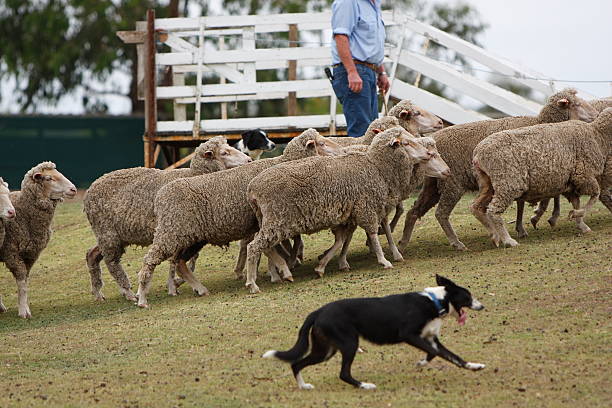What is Foot and Mouth Disease?
Foot-and-mouth disease (FMD) is a highly contagious viral disease that affects cloven-hoofed animals including: cattle, sheep, goats, pigs, camels, alpaca, llama and deer. FMD is an exotic disease, meaning it does not occur in Australia. Remaining vigilant is vital for serious diseases like FMD and early detection is the key to minimising social and economic impacts.
FMD is a notifiable disease. If you suspect your livestock are infected with FMD, you are legally obliged to report it. Contact the 24-hour Emergency Animal Disease Hotline on 1800 675 888.
How Does FMD Spread?
FMD spreads rapidly between animals by direct or indirect contact. The virus can be present in:
- saliva,
- breath,
- mucous,
- milk,
- faeces,
- blisters of infected animals, and
- airborne spread can occur over long distances.
Direct Contact
Direct contact is animal-to-animal contact, where animals may share a paddock, yard or pen.
Indirect Contact
Indirect contact is where animals come into contact with contaminated materials including:
- grass, straw, or wool.
- hands, clothing, shoes and equipment such as vehicles, tyres and so on.
- contaminated domestic animals such as dogs, cats, foxes and poultry that can carry the virus on their coats.
- carcasses of infected animals.
- airborne infection – for example, pigs excrete 1000 to 3000 times more virus than sheep or cattle, in their breath.
- swill feeding of meat from contaminated animals.
What are the Signs?
Signs can vary. Sometimes they are too subtle to detect, or the animal may appear depressed, have a fever. They may also be exhibiting some or all of the following:
- Sores and blisters develop on the mouth, tongue and/or feet (this is less prominent in sheep).
- Profuse drooling and smacking of lips.
- Sudden or uncharacteristic lameness (this is the main indicator in sheep).
- Tendency to lie down, and a reluctance to move, as a result of lameness.
- Raised temperature and reduced milk yield in cattle.
- Unwillingness to allow lambs to suckle in sheep.
Impact of FMD Outbreak
Industry
The cost of a large 12-month outbreak in Australia has been estimated at about $16 billion, or $50-$100+ billion over 10 years. The most significant impact would be to Australia’s agricultural export industry. An outbreak of FMD requires an extremely resource heavy response.
Our trade partners are not obliged to accept Australian exports and may impose their own timelines, if an outbreak occurred, possibly adding months to the process.
Severe social and economic impacts would be experience by other major industries including the tourism industry as well.
On-Farm
FMD does not usually kill adult animals, but it can be lethal in young animals, causing production losses.
The main way to control FMD is by humane slaughter of infected animals, movement bans and restrictions, preventing uninfected animals from being exposed to the disease, and possible vaccination of susceptible stock.
Human infections are very rare and are not serious. However, humans can carry the virus in their nose for up to 24 hours, spreading the infection to animals.
Who to Contact
If you see uncharacteristic footsoreness, drooling, blisters or unexplained deaths, call your preferred vet immediately or the 24 hour Emergency Animal Disease Hotline. False alarms are better than missing a case of FMD.

Treatment
Infected livestock are not treated, they are humanely euthanised to prevent further spread. Vaccination may be used by authorised people only to control an outbreak of the disease. It is not used as a preventative measure.
How Easily Can the Disease Enter Australia?
FMD was detected in Indonesia in May 2022. There are current statistics that suggest there is a 50% chance of FMD entering Australia in the next 5 years.
Australia has strict quarantine regulations in place on live animals, semen, uncooked meat or unprocessed dairy products, from FMD-affected countries or zones.
However, illegally imported contaminated animal products pose the greatest threat of introducing FMD. Feeding food waste to pigs, swill feeding, especially meat products, is banned in Australia for this reason. Swill feeding has caused outbreaks of FMD in other countries, including the 2001 outbreak in the United Kingdom.
Australia’s state of preparedness is continuously under review. There are plans, such as the AUSVETPLAN, in place to manage emergency and exotic disease outbreaks. Australia’s current plan is to detect the disease early and stamp it out.
Therefore, the most important factor in controlling FMD is finding it early.
Farm Biosecurity
Producers play a key role in protecting Australia’s livestock industries from pests and diseases by implementing sound biosecurity measures on-farm.
To find out more about building quick and simple biosecurity measures into everyday practices, and how these are an important safeguard against an FMD outbreak, visit www.farmbiosecurity.com.au.
Further Resources
Department of Agriculture, Fisheries and Forestry – FMD
Click here to download the PDF version.
For further information, please contact the VFF Livestock Group on 1300 882 833 or by email [email protected]
Disclaimer: All care is taken in the preparation of the information and published materials produced by the Victorian Farmers Federation (VFF) including but not limited to errors, defects or omissions in the information provided. VFF does not make any representations or give any warranties about the accuracy, reliability, completeness, or suitability for any particular purpose in the preparation of the information and published materials. This publication is intended for general information purposes only and does not constitute financial, legal, investment, production, or marketing advice. To the maximum extent permitted by law, the VFF and all persons acting on behalf of the VFF in preparing documents, are excluded from all and any liability for any loss or damage of any kind arising in relation to this publication including any reliance on the information contained herein.
